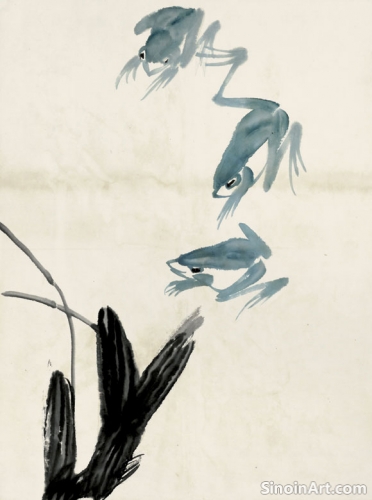Xieyi Painting and the Concept of 'Yi'
|
The term 'Xieyi' itself, often translated as "freehand" or "sketching ideas," is deeply rooted in the Chinese concept of 'Yi' (意). Yi goes beyond simple representation; it encompasses the idea, intent, meaning, and spirit of the subject, as well as the artist's inner understanding and feeling. Xieyi is not just about depicting what is seen but about expressing what is felt and understood. It’s about capturing the ‘essence’ rather than the literal depiction.  In Xieyi painting, the pursuit of 'Yi' is paramount. The artist aims to convey the inner essence of the subject, using simplified forms, spontaneous brushstrokes, and suggestive imagery. The artwork is not meant to be a perfect replica of reality, but rather an expression of the artist’s personal encounter with and understanding of that reality. It's about capturing the spirit and feeling of the subject, rather than its exact likeness.  The concept of 'Yi' also relates to the artist's intention and creative process. It's about painting from the heart and mind, rather than solely from the eyes. It emphasizes the importance of intuitive expression, allowing the artist's inner emotions and thoughts to guide their brushstrokes. Spontaneity is embraced as a means to achieve this deeper expression. The resulting art is the product of a unique inner experience.  'Yi' also involves the viewer's active participation in completing the artwork. The suggestive nature of Xieyi encourages viewers to engage their own imagination and experience to fill in the gaps and to interpret the painting in their own way. This interplay between the artist's intention and the viewer's interpretation is central to the art form's success. The artwork invites conversation and contemplation. The pursuit of 'Yi' is a lifelong journey for the Xieyi artist. It requires continuous exploration, experimentation, and a deep connection with both the natural world and the inner self. It’s not merely about technical proficiency but about achieving a state of harmony and unity with the subject, the materials, and the moment of creation. It is a spiritual and artistic quest. |
Tag : Yi in Chinese art, intent in painting, Xieyi essence, expressive art, understanding meaning
Related information
- Modern Interpretations and Contemporary Xieyi
- The Role of the Inkstone in Xieyi
- The Importance of Practice in Xieyi
- The Use of Color in Xieyi Painting
- Xieyi Painting and the Expression of Emotion
Modern Xieyi painting is adapting to contemporary contexts through incorporating new techniques, subject matter, and philosophical ideas, while remaining grounded in the core principles of spontaneity, expression, and the pursuit of qi, and pushing its boundaries into the modern art world.
The inkstone (yàn) is a vital part of Xieyi painting, influencing the quality and texture of ink, and serving as an object of both practical use and beauty, representing a key part of the ritual of painting and connecting the artist to tradition.
Dedicated and consistent practice is essential for mastering Xieyi painting, developing technical skills, intuition, and spontaneity, while also fostering patience, perseverance, and a deeper understanding of the art form's philosophy and aesthetics, transforming the practice into a form of self-discovery.
Color in Xieyi painting is used subtly and suggestively, often in light washes to create luminous effects, enhance meaning, evoke emotion, and accent specific areas of a composition, with colors often carrying symbolic connotations and adding depth to the artwork.
Xieyi painting is a powerful medium for expressing a wide range of emotions through brushstrokes, ink washes, subject matter, and the artist's state of mind, connecting with viewers on a deeply human and emotional level.